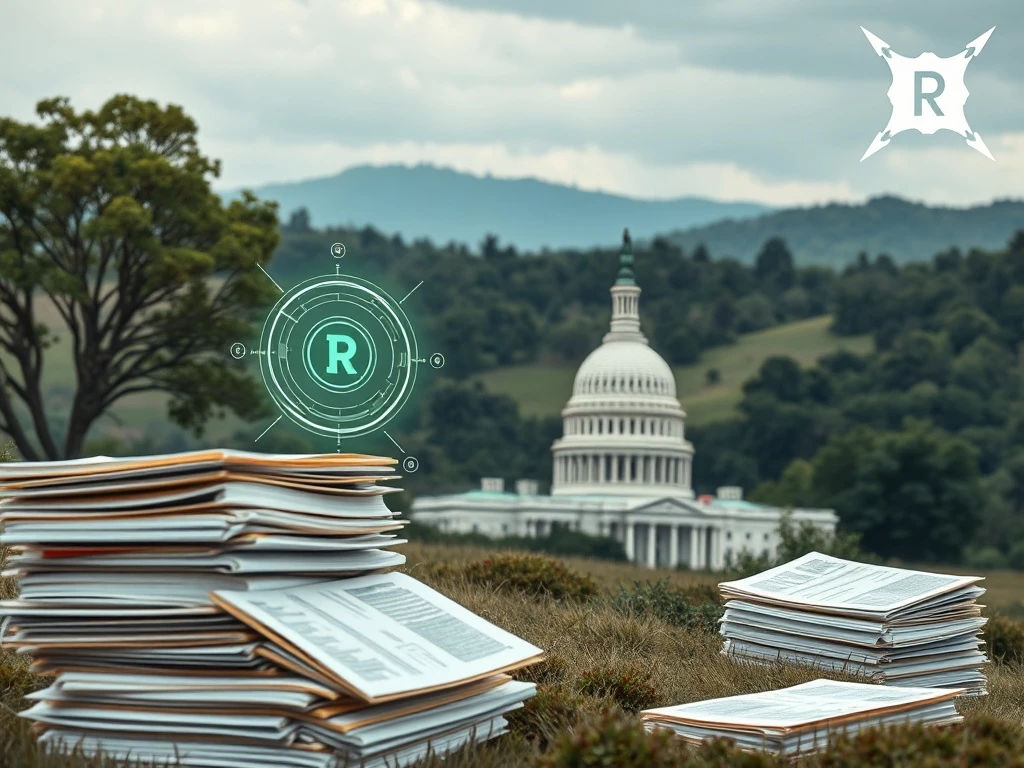Revolutionary DOGE AI Tool Targets 50% Federal Regulations Cut in 1 Year

Imagine a world where bureaucratic red tape is slashed, not by years of legislative debate, but by the swift, precise analysis of artificial intelligence. For anyone following the cutting edge of technology and its impact on society, especially within the cryptocurrency space where decentralization and efficiency are paramount, the latest initiative from the Department of Government Efficiency (DOGE) is nothing short of fascinating. They’ve just unveiled a groundbreaking DOGE AI tool aimed at an ambitious goal: cutting federal regulations by a staggering 50% within a single year.
Unveiling the Department of Government Efficiency (DOGE) and its Vision for Government Efficiency
The Department of Government Efficiency (DOGE) isn’t just a catchy acronym; it represents a bold new frontier in public administration. Tasked with the monumental challenge of streamlining governance, DOGE has launched a high-stakes initiative centered around its advanced DOGE AI tool. This project is positioned as a transformative step toward leveraging artificial intelligence for large-scale administrative reform, particularly in the context of a potential second Trump presidency, which has historically prioritized deregulation.
The core mission of DOGE’s latest venture is to systematically analyze and eliminate outdated or redundant rules from the vast U.S. federal code. This isn’t a small undertaking; the tool is designed to process approximately 200,000 existing regulations, aiming for a significant reduction in the regulatory burden within a year. The stated objective is clear: accelerate innovation, reduce compliance costs for businesses, and foster a more dynamic economy. It’s a vision that promises a leaner, more responsive government, making it an intriguing development for anyone interested in the intersection of technology and public policy.
The AI Deregulation Decision Tool: A Closer Look at its Ambitious Mandate for AI Deregulation
At the heart of this initiative is the “AI Deregulation Decision Tool.” This sophisticated AI is engineered to sift through hundreds of thousands of complex legal documents, identifying regulations that are no longer relevant, have overlapping provisions, or actively hinder economic growth without providing substantial public benefit. The tool’s capacity extends beyond mere identification; it’s designed to propose and even draft regulatory removals, significantly accelerating a process that traditionally takes years of human labor and legislative wrangling.
Early applications of this powerful tool have already targeted specific agencies, offering a glimpse into its potential. For instance, the Department of Housing and Urban Development (HUD) and the Consumer Financial Protection Bureau (CFPB) have been among the first to experience its impact. Reports from DOGE indicate that the AI has already drafted an astonishing “100% of deregulations” for the CFPB, showcasing its formidable capacity to both pinpoint and formulate regulatory removals. This level of automation, if proven reliable, could redefine how governments approach administrative reform.
The Promise of Reduced Federal Regulations: What’s at Stake?
The drive to cut federal regulations by 50% isn’t just about numbers; it’s about unleashing economic potential and improving daily life. Proponents of this initiative highlight several compelling benefits:
- Reduced Compliance Costs: Businesses, particularly small and medium-sized enterprises (SMEs), often spend significant resources navigating complex regulatory landscapes. A reduction in these rules could free up capital and time, allowing companies to invest more in growth, research, and development.
- Faster Innovation Cycles: Cumbersome regulations can stifle innovation by increasing the time and cost associated with bringing new products and services to market. Streamlining these processes could accelerate technological advancements and foster a more competitive environment.
- Improved Public Service Delivery: By removing redundant bureaucratic layers, government agencies themselves could become more agile and efficient, potentially leading to faster and more effective delivery of public services.
- Economic Dynamism: A less regulated environment is often argued to foster entrepreneurship and investment, encouraging new businesses to form and existing ones to expand, thereby stimulating overall economic growth.
The administration’s argument is that by removing these barriers, the economy could become more dynamic, fostering entrepreneurship and investment. This bold step could signal a new era where technological solutions directly address the challenges of governance, aiming to make the U.S. economy more agile and competitive on the global stage.
Navigating the Complexities: Challenges and Skepticism Surrounding Regulatory Reform
While the vision of a 50% cut in federal regulations is appealing, the path to achieving it is fraught with challenges and considerable skepticism. The White House has been quick to emphasize that “no final plans have been approved,” underscoring the complex approval processes, legal reviews, and intense scrutiny the project faces. This isn’t merely a technical exercise; it involves profound policy implications and potential legal challenges.
A significant concern stems from past issues with DOGE’s AI systems. Reports indicate that earlier iterations of their AI “hallucinated” data, such as exaggerating the size of Veterans Affairs contracts. This raises serious questions about the reliability and accuracy of the new AI Deregulation Decision Tool, especially when applied to high-stakes policy decisions. Critics caution that eliminating even seemingly outdated regulations risks unintended consequences, such as eroded consumer protections, weakened environmental safeguards, or even new legal liabilities. The sheer scale of the task—reviewing hundreds of thousands of rules—demands near-perfect execution, as errors could significantly undermine public trust and create unforeseen problems.
Elon Musk’s Shadow: Influence on DOGE’s Technological Approach
The initiative’s ties to Elon Musk’s involvement in DOGE’s early stages add another layer of intrigue. While Musk’s direct role in the development of this specific AI tool remains unclear, his well-known advocacy for technological efficiency, systemic problem-solving, and a streamlined approach to governance has undoubtedly influenced DOGE’s foundational philosophy. Musk’s vision often centers on using cutting-edge technology to solve complex, large-scale problems, a philosophy that aligns perfectly with the ambitious goals of the AI Deregulation Decision Tool.
His past pronouncements on reducing bureaucratic hurdles and his general tech-optimist stance suggest a philosophical alignment that could have shaped DOGE’s approach to leveraging AI for such a significant undertaking. This connection, whether direct or indirect, amplifies the public and media interest in the project, as anything associated with Musk often draws considerable attention and debate.
The Future of Governance: AI as a Global Model?
If successful, this initiative could serve as a global model for AI-driven governance, demonstrating how automation can address complex administrative challenges. The implications extend far beyond U.S. borders, potentially inspiring other nations to explore similar AI-powered approaches to regulatory modernization. Such a model would showcase the power of technology to enhance efficiency and responsiveness in public administration, offering a blueprint for future governmental structures.
However, it also raises broader questions about the ethical use of AI in policymaking. For AI-driven governance to gain widespread acceptance and trust, critical elements like transparency, accountability, and robust human oversight are paramount. Without these safeguards, concerns about algorithmic bias, unintended consequences, and the erosion of democratic processes could overshadow any efficiency gains. The debate around this DOGE AI tool will undoubtedly contribute to the ongoing global conversation about how societies can responsibly integrate advanced AI into core governmental functions.
A Pivotal Moment: The Intersection of Technology and Public Administration
The rollout of the AI Deregulation Decision Tool marks a pivotal moment in the intersection of technology and public administration. The stated 50% reduction goal is undeniably ambitious and politically charged, reflecting a significant shift toward data-driven governance. The outcomes of this project will depend not only on the AI’s technical capabilities but also on its ability to navigate bureaucratic inertia, overcome public skepticism, and withstand legal challenges.
If DOGE can effectively address past errors, demonstrate the tool’s unwavering reliability, and secure public trust, this project could genuinely redefine regulatory modernization, setting a new standard for governmental efficiency. Conversely, any significant missteps or failures could highlight the inherent limitations of autonomous systems in high-stakes decision-making, potentially leading to a backlash against AI integration in critical public sectors. The world watches to see if this revolutionary approach can deliver on its promises.
Frequently Asked Questions (FAQs)
Q1: What is the DOGE AI tool?
A1: The DOGE AI tool, part of the Department of Government Efficiency (DOGE) initiative, is an advanced artificial intelligence system designed to analyze and propose the elimination of outdated or redundant federal regulations in the U.S. federal code.
Q2: What is the main goal of this initiative?
A2: The primary goal is to reduce federal regulations by 50% within one year, aiming to streamline governance, accelerate innovation, and lower compliance costs for businesses.
Q3: What are the potential benefits of using AI for deregulation?
A3: Potential benefits include reduced compliance costs for businesses, faster innovation cycles, improved public service delivery, and fostering greater economic dynamism, entrepreneurship, and investment.
Q4: What are the primary concerns or risks associated with the DOGE AI tool?
A4: Concerns include past issues with DOGE’s AI systems hallucinating data, the risk of unintended consequences (e.g., eroded consumer protections), the need for complex approval processes, and ensuring reliability, accuracy, and public trust.
Q5: Has the DOGE AI tool been fully approved?
A5: No, the White House has emphasized that no final plans have been approved, indicating that the project still faces complex approval processes and scrutiny before full implementation.
Q6: How might this initiative impact businesses and consumers?
A6: For businesses, it could mean lower compliance costs and faster market entry for innovations. For consumers, the impact is less direct but could include benefits from a more dynamic economy, though there are also concerns about potential reductions in consumer or environmental safeguards if regulations are removed carelessly.









